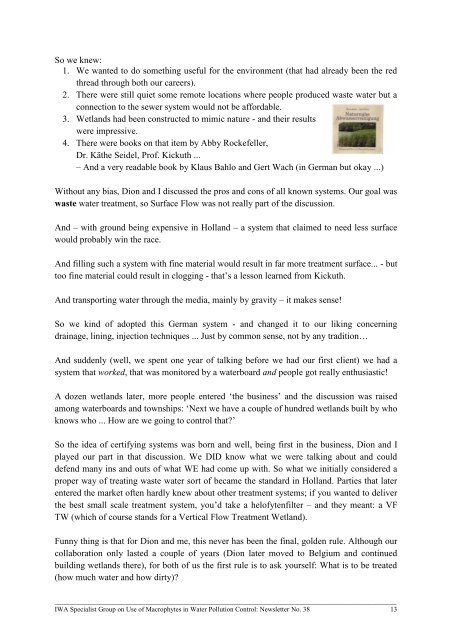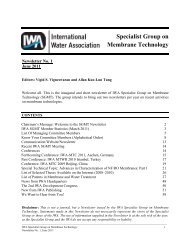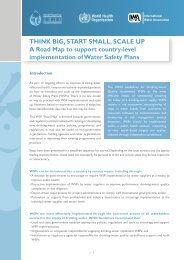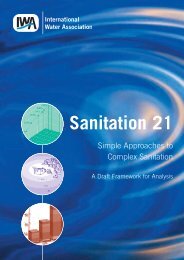Specialist Group on Use of Macrophytes in Water Pollution ... - IWA
Specialist Group on Use of Macrophytes in Water Pollution ... - IWA
Specialist Group on Use of Macrophytes in Water Pollution ... - IWA
You also want an ePaper? Increase the reach of your titles
YUMPU automatically turns print PDFs into web optimized ePapers that Google loves.
So we knew:<br />
1. We wanted to do someth<strong>in</strong>g useful for the envir<strong>on</strong>ment (that had already been the red<br />
thread through both our careers).<br />
2. There were still quiet some remote locati<strong>on</strong>s where people produced waste water but a<br />
c<strong>on</strong>necti<strong>on</strong> to the sewer system would not be affordable.<br />
3. Wetlands had been c<strong>on</strong>structed to mimic nature - and their results<br />
were impressive.<br />
4. There were books <strong>on</strong> that item by Abby Rockefeller,<br />
Dr. Käthe Seidel, Pr<strong>of</strong>. Kickuth ...<br />
– And a very readable book by Klaus Bahlo and Gert Wach (<strong>in</strong> German but okay ...)<br />
Without any bias, Di<strong>on</strong> and I discussed the pros and c<strong>on</strong>s <strong>of</strong> all known systems. Our goal was<br />
waste water treatment, so Surface Flow was not really part <strong>of</strong> the discussi<strong>on</strong>.<br />
And – with ground be<strong>in</strong>g expensive <strong>in</strong> Holland – a system that claimed to need less surface<br />
would probably w<strong>in</strong> the race.<br />
And fill<strong>in</strong>g such a system with f<strong>in</strong>e material would result <strong>in</strong> far more treatment surface... - but<br />
too f<strong>in</strong>e material could result <strong>in</strong> clogg<strong>in</strong>g - that‘s a less<strong>on</strong> learned from Kickuth.<br />
And transport<strong>in</strong>g water through the media, ma<strong>in</strong>ly by gravity – it makes sense!<br />
So we k<strong>in</strong>d <strong>of</strong> adopted this German system - and changed it to our lik<strong>in</strong>g c<strong>on</strong>cern<strong>in</strong>g<br />
dra<strong>in</strong>age, l<strong>in</strong><strong>in</strong>g, <strong>in</strong>jecti<strong>on</strong> techniques ... Just by comm<strong>on</strong> sense, not by any traditi<strong>on</strong>…<br />
And suddenly (well, we spent <strong>on</strong>e year <strong>of</strong> talk<strong>in</strong>g before we had our first client) we had a<br />
system that worked, that was m<strong>on</strong>itored by a waterboard and people got really enthusiastic!<br />
A dozen wetlands later, more people entered ‗the bus<strong>in</strong>ess‘ and the discussi<strong>on</strong> was raised<br />
am<strong>on</strong>g waterboards and townships: ‗Next we have a couple <strong>of</strong> hundred wetlands built by who<br />
knows who ... How are we go<strong>in</strong>g to c<strong>on</strong>trol that?‘<br />
So the idea <strong>of</strong> certify<strong>in</strong>g systems was born and well, be<strong>in</strong>g first <strong>in</strong> the bus<strong>in</strong>ess, Di<strong>on</strong> and I<br />
played our part <strong>in</strong> that discussi<strong>on</strong>. We DID know what we were talk<strong>in</strong>g about and could<br />
defend many <strong>in</strong>s and outs <strong>of</strong> what WE had come up with. So what we <strong>in</strong>itially c<strong>on</strong>sidered a<br />
proper way <strong>of</strong> treat<strong>in</strong>g waste water sort <strong>of</strong> became the standard <strong>in</strong> Holland. Parties that later<br />
entered the market <strong>of</strong>ten hardly knew about other treatment systems; if you wanted to deliver<br />
the best small scale treatment system, you‘d take a hel<strong>of</strong>ytenfilter – and they meant: a VF<br />
TW (which <strong>of</strong> course stands for a Vertical Flow Treatment Wetland).<br />
Funny th<strong>in</strong>g is that for Di<strong>on</strong> and me, this never has been the f<strong>in</strong>al, golden rule. Although our<br />
collaborati<strong>on</strong> <strong>on</strong>ly lasted a couple <strong>of</strong> years (Di<strong>on</strong> later moved to Belgium and c<strong>on</strong>t<strong>in</strong>ued<br />
build<strong>in</strong>g wetlands there), for both <strong>of</strong> us the first rule is to ask yourself: What is to be treated<br />
(how much water and how dirty)?<br />
____________________________________________________________________________________________________<br />
<strong>IWA</strong> <str<strong>on</strong>g>Specialist</str<strong>on</strong>g> <str<strong>on</strong>g>Group</str<strong>on</strong>g> <strong>on</strong> <strong>Use</strong> <strong>of</strong> <strong>Macrophytes</strong> <strong>in</strong> <strong>Water</strong> Polluti<strong>on</strong> C<strong>on</strong>trol: Newsletter No. 38 13

















